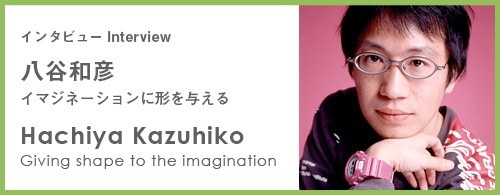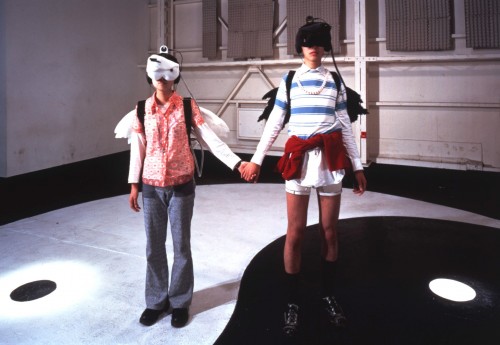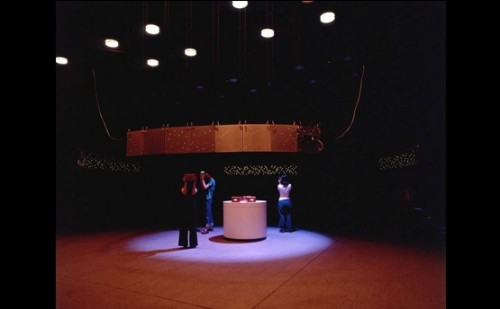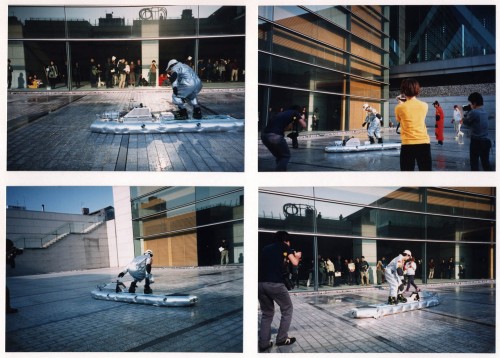
Interview: Sumitomo Fumihiko
– One of the biggest influences that visual images have is that they enable us to see how others view the world. In the fields of science and media theory, this idea of multiple viewpoints is increasingly recognized. Among your early works, there is Inter Dis-communication Machine, which enables one to experience another’s senses of sight and hearing face-to-face. The machine surprises by allowing us to assume someone else’s point of view. What motivated you to create it? Since Inter Dis-communication Machine you’ve continued to pursue the theme of viewpoints that depart from one’s own body. What prompted your interest?
 Inter DisCommunication Machine 1993 Photo Kurokawa Mikio
Inter DisCommunication Machine 1993 Photo Kurokawa MikioSometimes I imagine how the world must look for animals. For instance, frogs can only see moving objects. For dogs, the sense of smell must be a very important element of their world. For animals such as bats or dolphins, living by echo location means experiencing the world through their sense of hearing, so I wonder what that must be like. When I invented the Inter Dis-communication Machine I was interested in dolphins. I even went to Ogasawara to dive, and swam with wild dolphins. While preparing for the dive I practiced snorkeling and studied the biology of dolphins. One idea emerged: dolphins see the world through echo location. Perhaps they share the vision of others as well? Maybe it’s just my perception, but I found it interesting, so that’s why I made the machine, to realize this concept of sensing for human beings instead of dolphins.
– Your imagination took a giant leap. It doesn’t deny anthropocentrism, but it is like experiencing a whole new way of viewing the world, a non-human way. I think animation and manga have played a major role in depicting sympathetic communication between humans and other beings and creatures such as animals, yokai (monster spirits), aliens, and robots. It seems you’ve also been inspired by things outside of the art context. Would you mind telling us the animation and manga that have had the greatest influence on your works?
Specifically, these are the sources of my inspiration.
Seeing is Believing – The Little Prince by Antoine de Saint-Exupéry
Post Pet – Jojo’s Bizarre Adventure Part 4 by Hirohiko Araki, and Momo by Michael Ende
AirBoard – Back to the Future Part II by Robert Zemeckis
FairyFinder – Daremo Shiranai Chisana Kuni (A Little Country No-one Knows) by Satoru Sato
Open Sky – Nausicaä of the Valley of the Wind (manga) by Hayao Miyazaki
 Seeing is Believing 1996 Photo Oshima Kunio
Seeing is Believing 1996 Photo Oshima Kunio AirBoard 01,04,07 Photo Makihara Toshiaki
AirBoard 01,04,07 Photo Makihara ToshiakiI really like all these stories, and cannot help crying, not only once but every time I read them! However, aside from being a fan, I also chose them on purpose because I’d like my inventions to be based on things familiar to everyone. Basically what I want to do is physically create what’s in my imagination and express the conflict with the real world that arises when I do. For example, in AirBoard, the board had the disadvantage of not being usable on pavements because its heat would melt the asphalt. On the other hand, the ride was a far better experience than expected. I like to experiment within the gap between imagination and reality. That’s why I wanted to make something that would set people wondering ‘What would it be like if these machines and technology really existed?’
[…}
– Nowadays, lots of new Internet services are emerging, such as Mixi, Twitter, YouTube and Nico Nico Douga. You’ve also developed email software, called PostPet. Do you have a specific vision for the future of Internet communications? Do you already have ideas for using the Internet in a more stimulating way?
Well, for example, I saw the final issue of Studio Voice (a well-known Japanese culture magazine) today at a convenience store and felt so sad. I mean, I’m not entirely happy with the idea of promoting free web services. I think you never get something for nothing. So honestly I’d like to establish a service able to generate a proper income from users, though I still have no idea whether it would be a web service, an application or hardware. Maybe it will be totally different from my personal art activities. Excuse me if I go a bit off-topic, but Hiroyuki Nishimura, the former webmaster of 2channel (a Japanese Internet forum) sometimes calls himself a ‘media artist’, or maybe not anymore? Anyway I really think that’s the perfect job title. In my opinion the likes of 2channel and Nico Nico Douga are a form of media art – quite apart from how the designer and participants perceive them – when you consider their role in critiquing existing media. However, I also feel it’s because of the transition period we are currently in. In other words, TV or radio must have been in the same position in their early days. Maybe they had more creative freedom and were a bit more rough-and-ready as ‘youthful’ media. Current developments on the Internet look like media art, but I imagine that era could end soon, in the same way that video and mail art will eventually die out.
A revised excerpt from the interview translated by Takimoto Anna and Andrew Thomas published in
DEEP IMAGES – Why do we need images to live?
Edited by the Organizing Committee of the International Festival for Arts and Media Yokohama 2009
¥1,800 + tax ISBN: 978-4-8459-0938-4
Film Art http://www.filmart.co.jp/
In bookstores throughout Japan in early November (earlier at International Festival for Arts and Media Yokohama venues)
Hachiya Kazuhiko
Born 1966 in Saga, Hachiya Kazuhiko has developed numerous projects where he creates real versions of the imaginary devices that appear in manga, films and animation. He is also known as the developer of the email software PostPet and as the representative of the PetWORKs company that develops and produces software for PostPet.
http://www.petworks.co.jp/
Showing at the International Festival for Arts and Media Yokohama: Seeing is Believing
Mega Diary, released in 1995, is considered to be the forerunner to the modern-day blog in which personal words are seen in public spaces. Seeing is Believing is an interactive installation that allows us to see this via a special device. An updated version that will display the personal chit-chat from the networking service Twitter is also planned.
http://www.ifamy.jp/programs/single/519/
